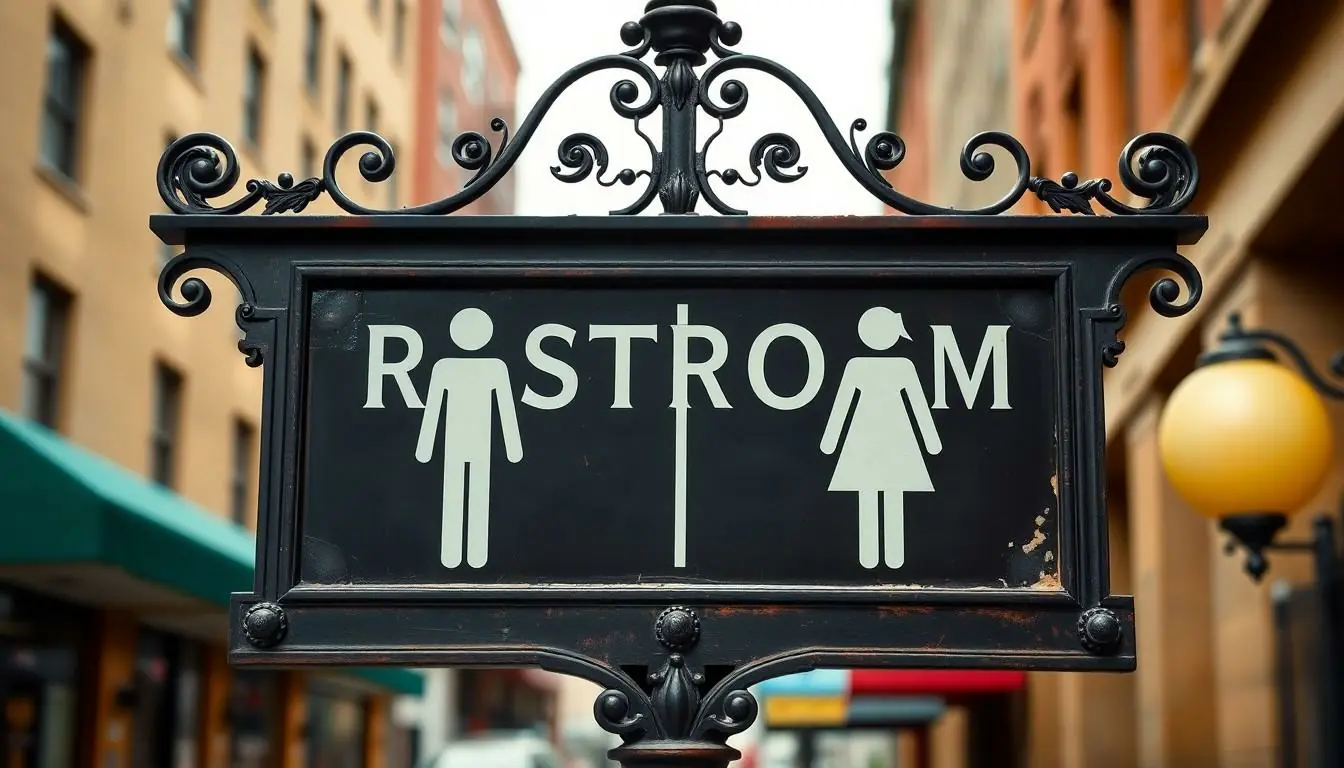Table of Contents
ToggleIn a world where everyone’s striving for equality, the concept of segregated bathrooms might seem like a relic from the past. Yet, these divided spaces still spark heated debates and raise eyebrows. Are they a necessary nod to tradition or an outdated practice that needs a serious makeover?
Imagine stepping into a bathroom where the only thing separating you from a potential awkward encounter is a flimsy door. It’s a scenario that’s both hilarious and cringe-worthy. As society evolves, the conversation around bathroom segregation becomes increasingly relevant. It’s time to flush out the myths and uncover what really lies behind those closed doors. Let’s dive into the bathroom battleground and explore the pros, cons, and everything in between.
Overview of Segregated Bathrooms
Segregated bathrooms divide facilities based on gender, common in schools, workplaces, and public areas. These spaces aim to provide privacy and safety for users. Opponents argue these divisions perpetuate outdated gender norms, placing undue stress on individuals who do not conform to traditional gender identities.
Historical roots trace back to the 19th century, focusing on societal norms and expectations regarding gender. Segregation often leads to exclusion for transgender and non-binary individuals. Many advocates suggest inclusive restrooms as a solution, promoting accessibility and comfort for everyone.
In various contexts, the discussion on segregated bathrooms includes not only gender but also cultural and religious considerations. Some argue mixed-gender facilities may result in safety concerns, while others emphasize equality and modernization. Data shows that gender-neutral bathrooms can significantly reduce harassment incidents, fostering a safer environment.
Emerging trends indicate a shift towards more inclusive bathroom policies, reflecting changing perceptions of gender. Progressive cities and organizations are increasingly adopting gender-neutral options, indicating a societal move away from traditional standards. Studies highlight that diverse restroom options enhance the sense of community and belonging among users.
Examining the impact of segregated bathrooms shines light on broader societal attitudes. Conversations around this issue reveal deep-seated beliefs about gender identity, safety, and personal space. Multiple viewpoints exist, making it essential to navigate this topic with sensitivity and understanding.
History of Segregated Bathrooms

Segregated bathrooms have roots deeply embedded in historical and social contexts. These gender-divided spaces emerged from the 19th century, primarily reflecting societal expectations of gender.
Origin and Development
The origins of segregated bathrooms trace back to the rise of industrialization and urbanization. As society transitioned, public health concerns emerged, leading to the establishment of separate facilities. Early advocates argued for safety and modesty, which influenced the segregation of restrooms. Each public space, including schools and workplaces, instituted these gender divisions. By the late 19th century, laws mandated gender-segregated facilities in many areas, institutionalizing separate spaces as a societal norm.
Social Influences
Social influences heavily shaped the development of segregated bathrooms. Gender roles, often rigidly defined, reinforced the need for distinct male and female spaces. Cultural beliefs regarding privacy and safety further contributed to this segregation. Movements advocating for women’s rights in the early 20th century pushed for better facilities, yet maintained the divide. Changes in societal attitudes toward gender, particularly in recent years, challenge these traditional norms. Advocacy for inclusivity now addresses the limitations of segregated bathrooms, especially concerning transgender and non-binary individuals, fostering ongoing debates on accessibility and comfort.
Arguments For Segregated Bathrooms
Segregated bathrooms play a significant role in maintaining privacy and comfort for individuals in various settings.
Privacy and Comfort
Segregated bathrooms provide individuals with a sense of security while using restroom facilities. Privacy becomes crucial in spaces where personal boundaries are essential, allowing users to feel at ease. Many people find comfort in shared experiences, particularly in gender-specific settings. Segregating bathrooms can minimize anxiety for those who feel vulnerable in mixed-gender environments. Studies reveal that users often report higher satisfaction levels in segregated facilities, pointing to a preference for environments where privacy is prioritized. Additionally, parents often express concerns for the comfort and safety of their children when using public restrooms, reinforcing societal calls for continued separation.
Cultural and Religious Considerations
Cultural norms greatly influence opinions on bathroom segregation. Many religious beliefs emphasize modesty, prompting proponents of segregated facilities to advocate for gender divisions. Some communities view mixed-gender environments as inappropriate based on traditional perspectives. Arguments cite that segregated bathrooms align with customary practices, providing spaces that meet specific cultural expectations. In multi-faith settings, ensuring that everyone feels respected and comfortable may make segregated restrooms necessary. Safety concerns also arise, as certain cultures associate comfort with the division of facilities. These considerations underline the complexity of the bathroom segregation debate, highlighting diverse viewpoints influenced by cultural and religious backgrounds.
Arguments Against Segregated Bathrooms
Opponents of segregated bathrooms highlight several critical issues that arise from this practice.
Gender Inclusivity
Inclusivity stands as a major concern. Segregated bathrooms alienate transgender and non-binary individuals, dictating which restroom aligns with their gender identity. Many individuals experience discomfort, anxiety, and fear in spaces that don’t reflect their identity. Research shows that gender-neutral facilities foster a welcoming atmosphere for all patrons. Eliminating strict gender divisions encourages community acceptance and recognizes diverse identities.
Psychological Impact
The psychological ramifications linked to segregated bathrooms cannot be overlooked. Segregation places immense stress on those who don’t conform to traditional gender roles, often causing feelings of isolation and alienation. Anxiety levels rise when people face potential harassment or discrimination in bathrooms designed solely for one gender. Studies reveal that inclusive restroom options can significantly reduce these negative mental health impacts. Realizing the need for safe, private facilities allows individuals to feel secure, improving their overall well-being.
Current Trends and Innovations
Increasingly, cities and organizations adopt gender-neutral bathrooms as part of inclusivity initiatives. Many progressive regions align policies with contemporary values, focusing on accessibility for all individuals, including transgender and non-binary people. Data reveals that such facilities significantly reduce harassment incidents, creating safer environments for everyone.
Emerging designs showcase private, individual stalls in gender-neutral bathrooms, enhancing comfort and privacy. Architects emphasize the importance of layouts that accommodate diverse user needs, integrating features like automatic doors and enhanced cleanliness. Many designs also include family-friendly options, connecting spaces for parents and caregivers with children.
Research supports the psychological benefits of inclusive restrooms. Studies indicate that gender-neutral options promote community acceptance, helping individuals feel more secure and welcomed. People who utilize these facilities report decreased anxiety levels, contributing to improved mental health outcomes.
Inclusivity initiatives arise from various sectors, including corporate offices. Organizations increasingly recognize the importance of fostering diversity through restroom policies. Universities and educational institutions implement gender-neutral bathrooms, aligning with student demands for safe and accommodating spaces.
Furthermore, legislative changes influence bathroom policies. Many states are introducing laws mandating gender-neutral facilities in public buildings, reflecting shifting societal attitudes. Stakeholder engagement, including discussions with community members, shapes these developments, ensuring representation of diverse voices and needs.
Overall, the current landscape of bathroom facilities evolves rapidly, driven by collective efforts toward inclusivity and understanding. As society progresses, these innovations represent a critical response to the complex dynamics surrounding gender identity and accessibility.
The debate over segregated bathrooms reflects broader societal shifts regarding gender identity and inclusivity. As communities increasingly recognize the importance of accommodating diverse identities the call for gender-neutral facilities grows stronger. These spaces not only enhance comfort and safety but also foster a sense of belonging for all individuals.
The evolving landscape of bathroom policies indicates a movement toward modernization and equality. By embracing inclusive restroom options society can create environments that respect personal identities and promote mental well-being. The future of bathroom accessibility hinges on understanding and addressing the needs of everyone, ensuring that all individuals feel safe and accepted in public spaces.




